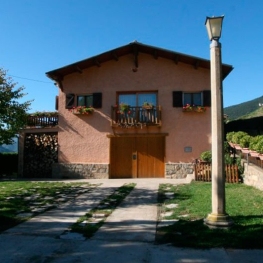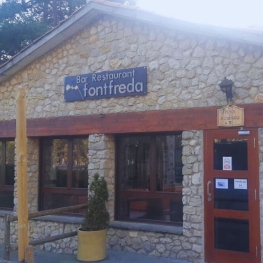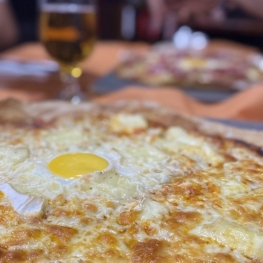Textil colonies in Berguedà

On this route, from femturisme.cat, we invite you to visit an important part of our heritage: industrial colonies. Specifically this route focuses on textil colonies located along the Llobregat River came to be built up to 15 different textile colonies. The colony Rosal, Vidal colony, the colony Viladomiu ... all are examples of this historical fact and where you can stroll along the heritage that conserve and know the environment that existed in ancient times there, the hurrying home from work home to work and live immersed in a "social peace". Some stories that left traces the Berguedà!
 In the late eighteenth century rural areas away from the big city and the river was spent which were the focus of many manufacturers of the time in order to install a textile industry and advantage that in this way the power of water to make operate machinery and saved, economically speaking, energy.
In the late eighteenth century rural areas away from the big city and the river was spent which were the focus of many manufacturers of the time in order to install a textile industry and advantage that in this way the power of water to make operate machinery and saved, economically speaking, energy.
With the facilities of these industries began the birth and evolution of the colonies as opening textile factories involved creating housing for the workers they had a home life which was limited to this environment.
 The Berguedà was one of these areas, where on a 20 kilometer stretch of the river paths even installed up to 15 different textile colonies. In fact, the settlement of these factories generated economic and social developments of great impact for the region.
The Berguedà was one of these areas, where on a 20 kilometer stretch of the river paths even installed up to 15 different textile colonies. In fact, the settlement of these factories generated economic and social developments of great impact for the region.
Today, of these colonies is a quiet and calm dominated riparian forests, which are the controversy of what had been formerly. But still there are the buildings that have witnessed the colonies and remember many years of work and different lives.
The colony Rosal, Vidal colony, the colony Viladomiu ... all are examples of this historical fact and all you can stroll along the heritage that conserve and know the environment that existed years ago, there, the work to rush to home and from home to work to live submerged in a "social peace".
Some stories that left traces the Berguedà!
The model of life in the colonies
An industrial colony was home to a people that was dedicated to the production of cotton fabrics based on the size of the factory.
As the colony was located in rural areas far from population centers and near the river, and as communications that existed then were not like today's, homes were built in the factory environment in order to provide accommodation workers.
 Normally, these two spaces are distinguished at a glance. It only takes walking by any colony! On one side was the factory and its components-turbines, prey ... - and on the other, housing and services, schools, church, coffee ... -. Also often differed a third space, the Tower of l'Love (Tower Owner). This tower is located in the highest point of the colony and was the house where he was staying the owner or his family when they visited the factory to ensure its smooth operation, as they often do not live in the colony.
Normally, these two spaces are distinguished at a glance. It only takes walking by any colony! On one side was the factory and its components-turbines, prey ... - and on the other, housing and services, schools, church, coffee ... -. Also often differed a third space, the Tower of l'Love (Tower Owner). This tower is located in the highest point of the colony and was the house where he was staying the owner or his family when they visited the factory to ensure its smooth operation, as they often do not live in the colony.
 In this aspect, the church was also a highlight of the colony as it was one of the main areas where he spent much of the life of its inhabitants. However it should be clear that each colony was different and had its own structure. Some homes were more remote from the factory than others, some had more or less services, etc..
In this aspect, the church was also a highlight of the colony as it was one of the main areas where he spent much of the life of its inhabitants. However it should be clear that each colony was different and had its own structure. Some homes were more remote from the factory than others, some had more or less services, etc..
The homes of working families were, usually, apartment buildings of two or three-story homes were divided into 50 to 80m2 with kitchen, dining room and bedrooms. The bathrooms were located in a foreign galleries.
 The homes became one of the main spaces of the colony and his street was known as "the street of the story" and was where were located various service establishments, the oven, shop, coffee ...
The homes became one of the main spaces of the colony and his street was known as "the street of the story" and was where were located various service establishments, the oven, shop, coffee ...
The families residing in the colony and occupied dwellings were committed to factory work. Whenever there was a member who could work and was sent to work there. In this sense, the working men and women not only worked in these areas but also lived and passed their lives together with the family.
Berguedà The first colony, the colony Rosal
 The birth of the textile colonies in Berguedà, giving rise to 15 different industries, began with the installation of the colony Rosal. The colony was owned by the family Rosal, who in 1858 bought some land near the town of Berga at the foot of the Llobregat river.
The birth of the textile colonies in Berguedà, giving rise to 15 different industries, began with the installation of the colony Rosal. The colony was owned by the family Rosal, who in 1858 bought some land near the town of Berga at the foot of the Llobregat river.
Aiming that the owner, plus a ground necessitaba grant have a waterfall to build the factory, as this would enable her to jump the energy required for the operation of the factory machines.
 This colony, who performed spinning, weaving, finishing and dyeing, left its mark on the region Berga. Not only for being the first to be placed in the area but why was the one that had a greater number of workers. It is said that they came to work there over a thousand people.
This colony, who performed spinning, weaving, finishing and dyeing, left its mark on the region Berga. Not only for being the first to be placed in the area but why was the one that had a greater number of workers. It is said that they came to work there over a thousand people.
Furthermore, Rosal family was one of the promoters for the railroad came to this region. It is true that they did for the benefit of the factory as they needed it was connected to Barcelona for better marketing of their products and to receive raw materials for processing, but, indirectly benefited the whole territory.
So Cal Rosal had their own station from 1887.
The family Viladomiu
Viladomiu family was one of the most famous and important families of Berguedà because it was owned four different colonies: Viladomiu Vell, Cal Marcal, Viladomiu Nou and Guixaró.
 The Viladomiu were a family with textile tradition since the seventeenth century were known as wool merchants and weavers. And also, the father of the founder of Viladomiu Vell, above, did business related to the world of spinning and weaving.
The Viladomiu were a family with textile tradition since the seventeenth century were known as wool merchants and weavers. And also, the father of the founder of Viladomiu Vell, above, did business related to the world of spinning and weaving.
The first colony was built on the plain Viladomiu Vell de Sant Marc in 1871. This colony was important for the large number of services offered to its workers, houses, butchers, tailors, school, hostel, theater, football, church ...
Also noteworthy is the Nou Viladomiu colony, which is also located south of Gironella and near Viladomiu Vell, as it was one of the colonies that, in the 70s, to fight the crisis, received coach full of people who were not part of the colony but who moved there to work. But finally had to close its doors.
Currently, the tower owner of Viladomiu Nou is a tourist office in the Parc Fluvial Llobrega t.
The colony Vidal Puig-Reig
Around the town of Puig-Reig place is reached seven industrial estates, which permitío that Puig-Reig was the first town reached by rail.
 One of the seven most significant colonies of Puig-Reig and perhaps the best known of the Llobregat river Parc is the Colonia Vidal. This was the last that was opened in Berguedà, in 1900. The place where it is located was the only empty space left between the colony and Nava Rosal. The rest was occupied by other colonies.
One of the seven most significant colonies of Puig-Reig and perhaps the best known of the Llobregat river Parc is the Colonia Vidal. This was the last that was opened in Berguedà, in 1900. The place where it is located was the only empty space left between the colony and Nava Rosal. The rest was occupied by other colonies.
Currently, in this colony can make a highly recommended tour, and knowing what his operation and production process. Also, you can access a floor of a working class family, school or library, among other venues. Just as walking down the street of Sant Ignasi, which was the first to be built.
 Curiously include the Theatre which opened in 1947 and is a miniature replica of the Gran Teatro del Liceo, but now is in ruins due to a indencio.
Curiously include the Theatre which opened in 1947 and is a miniature replica of the Gran Teatro del Liceo, but now is in ruins due to a indencio.
At the entrance of the colony, opposite the church, is the Colonia Vidal Museum, which offers guided tours of the colony. Also, what was the old train station (next to the C-16) has become, today, at the gateway to the colonies textiles del Llobregat as it hosts a tourist office.
The reasons for settlement of the colonies
The reason these territories entrepreneurs chose to locate their industries goes beyond jump harness the power of water for energy in order to operate the machinery. Although this was the main objective.
 Also, the location of the factory at the foot of a river brought many benefits. For example, the moisture that was generated river for textile beneficial especially for what concerns the production of yarn.
Also, the location of the factory at the foot of a river brought many benefits. For example, the moisture that was generated river for textile beneficial especially for what concerns the production of yarn.
In addition, selected territories where the river were passed rural character and they were far from the city. This allowed to have controlled the worker and create a stable working environment and life framed in the "social peace" and the industrial paternalism, avoiding therefore social conflicts, for example, is generated in large cities such as Barcelona .
Paternalism was a way to control workers with providing services to the colony workers entertained with the little free time they had.
These territories to be isolated from the big cities were lands that had little economic value and could be purchased at a reasonable spacious and low price. Also took advantage of tax breaks for working in this area.
 For the same reason, as rural areas there was a lot of manpower available derivative of the farmers living in poverty as a result of not being able to make a living in the field, preferring to work in a factory 12 hours a day and have thus salary at month end. Moreover, this population had traditions based on textiles and knew this world.
For the same reason, as rural areas there was a lot of manpower available derivative of the farmers living in poverty as a result of not being able to make a living in the field, preferring to work in a factory 12 hours a day and have thus salary at month end. Moreover, this population had traditions based on textiles and knew this world.
Therefore, the reasons for the location of industries in these areas were completely different and of different character: geographic, economic and social.
What to do
Museu de la colònia Vidal de Puig-Reig
Puig-reig (a 3.2 Km)A visit to the Colonia Vidal de Puig-reig allows us to understand…
Granja Natura (Centre d'Apropament a la Natura)
Navàs (a 9.5 Km)Live a unique experience in close contact with farm, wild, and exotic…
Centre d'interpretació de l'Església de Cal Pons
Puig-reigThe Interpretation Center of the Colonia Pons Church, through three museum spaces,…
Where to eat
Hostal de Montclar
Montclar (a 10 Km)Located in the town square of Montclar, in the south of Berguedà,…
Restaurant Font Freda
Castellar del Riu (a 4 Km)A restaurant offering a wide selection of Catalan dishes, especially notable for…
Bar Restaurant Xato
GironellaOrder pizzas, burgers, tapas... at Xato Bar-Restaurant and we'll deliver them to…
Where to sleep
Hotel Casa Duaner
Guardiola de Berguedà (a 14.9 Km)The Casa Duaner Hotel in Guardiola de Berguedà offers modern facilities, a…
Restaurant Apartaments Els Roures
Castellar del Riu (a 4 Km)Rest, charm and good cuisine, a unique space located in Berguedà, at…
Cal Fargas Turisme Rural
Santa Maria de Merlès (a 8.5 Km)At Cal Fargas, comfortable rooms await you in a house surrounded by…





















